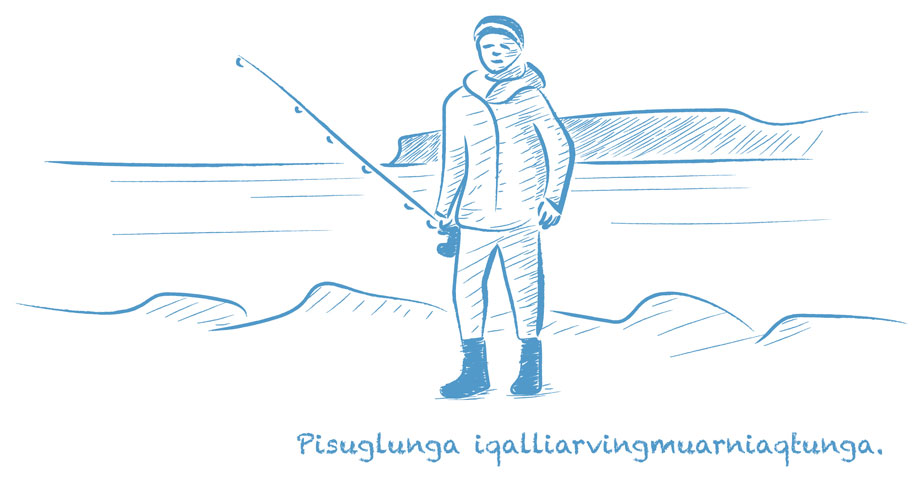This chapter deals with verbs, or words that describe actions, events or states of being:
anijuq
He/she goes out.
pisuktugut
We (3+) walk.
taqajusik
You two are tired.
quviasuktut
They are happy.
Inuktut verbs always have a root and a verb ending:
ullak + tunga = ullaktunga
I run.
uirngaq + tusik = uirngaqtusik
You two are sleepy.
One or more affixes can appear between a root and the verb ending:
pisuk + giaqaq + niaq + tunga = pisugiaqarniaqtunga
I will have to walk.
Verb Endings
All verb endings give two types of information:
- The function of the verb in the sentence.
- Who is doing the action or who is in a state. There are single, dual and plural verb endings:
Unnualimaaq sinilauqtuq umiarmi.
He/she slept all night on the boat.
Unnualimaaq sinilauqtuuk umiarmi.
The two of them slept all night on the boat.
Aakuluk, Kunuk, Piitalu unnualimaaq sinilauqtut umiarmi.
Aakuluk, Kunuk and Peter slept all night on the boat.
The third person endings do not differentiate between he/she/it:
For example, the -tuq ending tupaktuq could refer to a male (he), a female (she) or an animal (it).
Variations of Verb Endings
Most verb endings change their forms depending on the last letter of the root they are added to.
Some endings have two forms – one that is used after a vowel (i, u, a) and one that is used after a consonant (q, k, t):
-jugut / -tugut
we (3+) do something
utaqqi + jugut = utaqqijugut
aullaq + tugut = aullaqtugut
Other endings have different forms for roots ending in a vowel, –q, –k or –t:
-gavinnga / -ravinnga/ -kavinnga / -navinnga
because he/she/it…me
taku + gavinnga = takugavinnga
malik + kaviuk = malikkavinnga
qungat + naviuk = qungannavinnga
ikajuq + ravinnga = ikajuravinnga
Different functions of verbs
There are different sets of verb endings depending on the function of the verb in the sentence. Different endings are used to make statements, ask questions, or tell someone to do something:
| nirijutit | You are eating. | statement |
| nirivit? | Are you eating? | question |
| nirigit! | Eat! | command |
The most common verb functions and their endings are covered below.
Nalunaiqsijjutit (statements)
These endings are used for making simple statements about events.
Sailasiup ataatanga aullaqqaujuq umiakkut.
Sailasi’s father left earlier by boat.
Taqajugut.
We are tired.
Taakkua piugijakka.
I like these things.
Statement endings generally begin with j when added to a stem ending in a vowel.
The j changes to a t when the ending is added to a stem ending in a consonant:
pisuk + tugut = pisuktugut
ilau + jugut = ilaujugut
There are however alternate forms of these statement endings that are frequently used when responding directly to a question. In these instances, the first letter of the ending begins with v after a vowel and with p after a consonant:
Nirisimavit?
Have you eaten?
Niriliqpit?
Are you eating right now?
ii, nirisimavunga
Yes, I have eaten.
ii, niriliqpunga
Yes, I am eating.
Apiqsurutit (questions)
There is a set of endings attached to verb roots for asking questions:
Niuvirvingmut maligumavit?
Do you want to come along to the store?
Kikkullu taikunngarniaqpat?
Who else will be going there?
There is a related set of endings for asking if something is not happening. These endings are added to the negative affix –nngit:
Anijjaanngilagut?
Are we not going out?
Suli atuinnaunngilaq?
Is it still not ready?
Tilisijjutit (commands)
These verb endings are used for telling someone to do something or for suggesting something that you would like to happen. They fall into three groups:
(i) Commands where the action will be performed by the person/people one is speaking to:
Utaqqigit!
Wait! (command to one person)
Utiritti!
Come back! (command to 3+ people)
Qaijjuk!
Give it to me! (command to 1 person)
(ii) Commands where the action will be performed by the person who is speaking:
Atulaukaglaakkak!
Let me use the two of them for a bit!
Nirita!
Let’s eat! (command to 3 people)
(iii) Commands where the action will be performed by a third party:
Ingillit!
Let them sit down!

Pisimajuqsiutit (because/when)
This set of endings is used to mark a verb as an explanation or a circumstance of some other statement.
A verb with one of these endings indicates either:
(i) the reason another event occurred:
Aullalaunngittunga qanimalaurama.
I didn’t travel because I was sick.
(ii) when an event happened in the past:
Pijariiramik umiarmut ikijaqtulilauqtuuk ataatagiik.
When the two were finished he and his father went to get on the boat.
In the third person, where he, she, it or they is performing the action there are two sets of endings:
Aanniaramik anilaunngittuuk.
The two of them didn’t go out because they were sick.
Qiturngangik aanniarmatik anilaungittuuk.
The two of them didn’t go out because their children are sick.
In the first sentence the people who were sick are the same people who did not go out. –ramik is an example an ending that that is used to connect a verb with another event/action performed by the same person. In the second sentence the people who were sick are not the same as the ones who did not go out. –matik is an example of an ending that can be used to connect a verb with an event/action that is performed by another person.
This distinction is similar to the noun endings described in section 4.2 (his versus his own).
Pituinnarialit (if/when)
A verb with one of these endings either:
(i) sets conditions that have to be met for another event to happen:
Sila piukpat nunivalaaqtugut.
If the weather is good, we will be berry picking.
Qaigussi quviasungniaqtunga.
If you (3+) come, I will be happy.
(ii) describes when events will happen in the future:
Tikikkuvit aijaulaaqtutit.
You will be picked up when you arrive.
Nirijariirutta aniniaqtugut.
We will leave after we eat.
The if/when endings also have two forms depending on whether the two actions will be performed by the same person on by different people:
Anaanaga qaikpat niqłiurniaqtunga.
When my mother arrives, I will make some food.
Anaanaga qaiguni niqłiurniaqtuq.
When my mother arrives, she will make some food.
Atauttikkuuqtut (2 simultaneous events)
These endings join an event with another event happening at the same time:
Angutilimaat quviasukłutik nirilauqtut.
All the men were happy as they ate.
The basic form of these endings is used when the related actions are being performed by the same person or people, either in the present or in the past.
Tuavirasukłunga aullalauqtunga.
I tried to hurry as I departed.
If the two actions that are linked are performed by different people, the prefix ti– is added before the ending:
Siniktillutit niuvirialauqtunga
While you slept, I went shopping.
1951–ngutillugu nunaliralaangulauqsimajut.
It being 1951, there were outpost camps.
The above examples all describe actions in the past. With a slight change, these endings can be used to describe actions in the future:
Pisuglunga iqalliarvingmuarniaqtunga.
I will go to the fishing spot by foot.
The future form of these endings can also be used as a less direct and more polite way of telling someone to do something:
Anilutit takujaqtulaurit kinaungmangaat!
Go out and see who it is.
Matuirlugu!
Please open it!
There is a related set of endings that indicate that something was not happening while another event was taking place:
Sinilaurnani aullaqtuq.
He departed without having slept.
Tukisinatik angituinnalauqtut
Not understanding, they simply agreed.
These endings can also be used to tell someone not to do something:
Takunak!
Don’t look!
Tigunagu!
Don’t take it!
